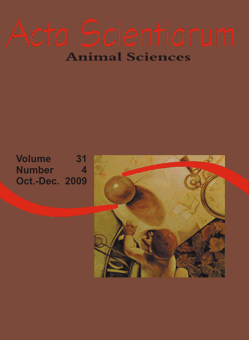<b>Production of seedlings of forage species in floating hydroponics system with biofertilizer or soluble fertilizer</b> - DOI: 10.4025/actascianimsci.v31i4.7459
Keywords:
hydroponic, pasture, Axonopus catharinensis, forage peanut, greater lotus
Abstract
Production of seedlings of forage species in floating hydroponics system with biofertilizer or soluble fertilizer. The aim of this work was to evaluate the survival and dry matter production during the seedling culture phase of three forage species: Axonopus catharinensis, forage peanut (Arachis pintoi), and greater lotus (Lotus uliginosus cv. Maku), in a floating hydroponic system using biofertilizer or soluble fertilizer. The experimental design adopted was randomized blocks in a 3 x 2 factorial scheme, with three forage species and two fertilizers. There was no difference between species with regard to survival (p = 0.225), regardless of the fertilizer used (p = 0.92). However, when dry matter production was considered, Maku (p = 0,001) showed greater weight (47.18 g), while there was no difference (p = 0.227) in weight between Arachis pintoi (19.90 g) and Axonopus catharinensis (16.81 g) or between fertilizers (p = 0.559). Thus, all three forage species have similar survival conditions, regardless of nutrient concentration of the fertilizer, and Maku had greater dry matter production.Downloads
Download data is not yet available.
Published
2009-11-26
How to Cite
Probst, R., Quadros, S. A. F. de, Erpen, J. G., & Vincenzi, M. L. (2009). <b>Production of seedlings of forage species in floating hydroponics system with biofertilizer or soluble fertilizer</b> - DOI: 10.4025/actascianimsci.v31i4.7459. Acta Scientiarum. Animal Sciences, 31(4), 349-355. https://doi.org/10.4025/actascianimsci.v31i4.7459
Issue
Section
Pasture and forage utilization
DECLARATION OF ORIGINALITY AND COPYRIGHTS
- I Declare that current article is original and has not been submitted for publication, in part or in whole, to any other national or international journal.
The copyrights belong exclusively to the authors. Published content is licensed under Creative Commons Attribution 4.0 (CC BY 4.0) guidelines, which allows sharing (copy and distribution of the material in any medium or format) and adaptation (remix, transform, and build upon the material) for any purpose, even commercially, under the terms of attribution.
Read this link for further information on how to use CC BY 4.0 properly.
0.9
2019CiteScore
29th percentile
Powered by 








































